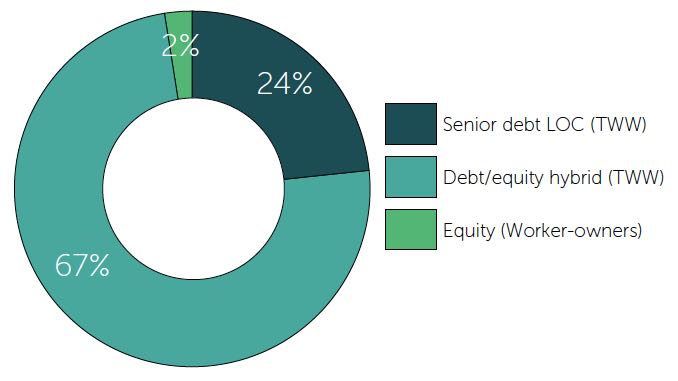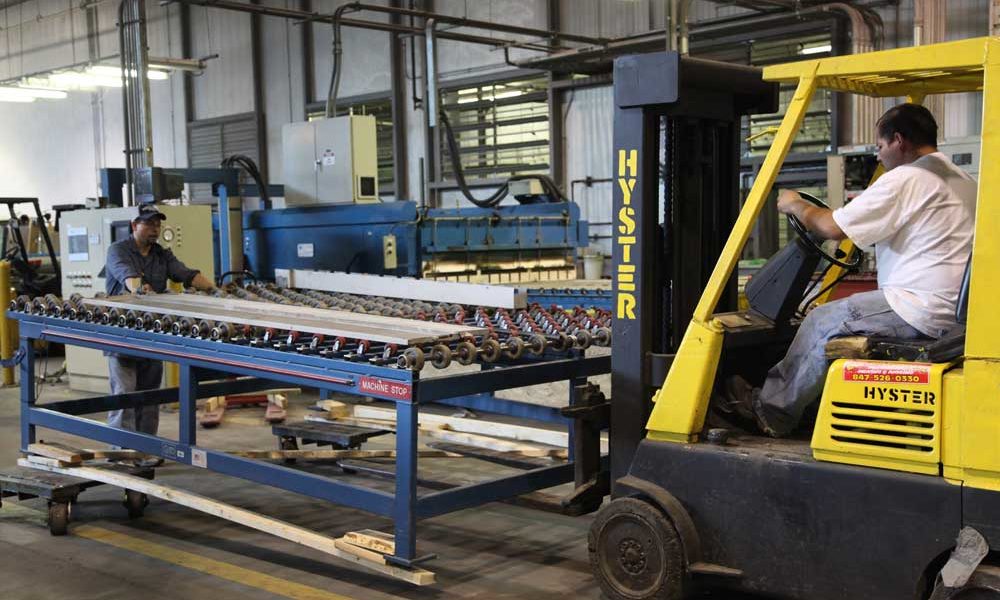New Era Windows deal structure
New Era Windows Financing
- Chicago, IL
At a Glance
New Era Windows is a cooperative started by workers from the remains of their bankrupt former employer. Union organizing laid the foundation for its development and it received significant outside cooperative development support.

- Industry: Manufacturing (Windows)
- Location: Chicago
- Year converted: 2013
- Total capital: $850,000
- Annual revenue at sale date: $0
- Worker-owner buy-in: $1,000
- Worker-owners: 16 (20 employees)
- Primary financing source: 10 year term loan at 5%, interest accrues but repayment only when company is profitable, from The Working World
- Lenders: 1
Background
Industry: New Era Windows is a Chicago-based window manufacturer that offers energy-efficient vinyl windows. The company has a stated mission to support community, to keep quality jobs in America, and make the Chicago area economy stronger.
Size: The company currently has 20 employees (16 members and 4 other employees) and generated $1M in gross revenue in 2015, its most recent year.
Cause of Conversion: New Era Windows has a unique conversion story. In 2008, a company called Republic Windows and Doors filed for bankruptcy and closed, despite the fact that the business was generating profits. The workers were told that their jobs would be terminated immediately, and that they would not be given their contractually obligated backpay or severance. The workers decided to occupy the factory in protest, and the community came out to support them. The workers and the community won enough of this struggle to get the money that was owed to them. A new green construction company, Serious Energy, took control of the factory and partially reopened it. Serious Energy’s business plan, which only involved the windows factory in a tertiary role, never functioned, and the company had to severely cut back on its operations, including closing the factory again in 2012. The workers decided to reopen the company as a worker cooperative, and sought the help of the United Electrical Workers Union, The Working World, and the Center for Workplace Democracy. The new cooperative started generating revenue in 2013.
Sale Price: New Era Windows did not technically purchase a business. The workers purchased assets from the former factory, which were being auctioned by its creditors. The workers had the option to decide which what assets to purchase, and the equipment they chose went for a total of $430,000.
Financing
A key partner in the conversion process, the Working World provided all of New Era’s outside financing, including both the asset purchase and working capital.
Source | Amount | Notes |
The Working World | $430,000 | 10 year term loan at 5% for $430,000 asset purchase,fully secured by equipment purchased with the loan(which was bought at salvage price). Interest accrues, but repayment only when the company is profitable. |
The Working World | $200,000 | 10 year term loan at 5%, plus the equivalent of one member’s profit share. Interest accrues, but repayment only when the company is profitable. Unsecured |
The Working World | $200,000 | $200,000 line of credit at 5%. Secured with any materials purchased with the funds |
Worker-Owners Equity | $20,000 | Equity buy-in set at $1,000 per member |
| Total Sources | $850,000 | |
Asset Purchase | $430,000 | |
Acquisition Working Capital | $420,000 | |
Total Uses | $850,000 |
Underwriting
The Working World has a unique model that only secures financing with collateral purchased with the loan and does not use personal guarantees. To offset risk, the Working World provided extensive technical assistance to New Era Windows to increase the likelihood of the company’s success, which is subsidized with grant funding. Although some of the financing for the New Era Windows transaction is secured with assets purchased with funds provided by the Working World, an estimated 50%-75% of the financing is unsecured.
1. Collateral (+/-) Collateral primarily consisted of the $430,000 in purchased equipment, which likely has a value at or near the purchase price because of the reduced rate paid at auction. The additional $200,000 of working capital provided at closing is not collateralized. The line of credit is not fully secured, but has a lower risk profile because the company primarily purchases raw materials with the line of credit, which are collateral, and repays the draws frequently.
2. Capacity (-) At the time of conversion, New Era Windows was not yet generating revenue. While workers had the experience and skills necessary to produce the product, there were capacity gaps with regard to sales experience and administrative skills. Knowing there was not enough capital to hire additional personnel—and in order to deepen their own experience inside cooperatives— the Working World helped to fill these gaps with their own personnel, subsidized through grant funding. The company now has sales and administrative staff, and the Working World is phasing into a reduced technical assistance role. The company had $500,000 in revenues in 2014, which doubled to $1,000,000 in 2015.
3. Capital (+/-) The equity buy-in for member-owners was set at $1,000 per member. Almost all workers were able to provide the purchase price up front, resulting in approximately $20,000 in equity. The debt to equity ratio after the conversion has been between 1.5 and 1.7 depending on the draw on the line of credit.
4. Character (+) At the time of conversion, New Era Windows did not have a credit history and the worker-owners did not have a history of running a business independently. However, they had demonstrated their commitment to starting a business together through their willingness to occupy their factory and attend many planning meetings. The Working World worked closely with the founding worker-members, who demonstrated strong problem-solving skills and other leadership qualities. Brendan Martin, Executive Director of the Working World, describes an incident that demonstrated their leadership skills and commitment:
Soon after we had purchased the equipment and had only raised $200,000 in working capital, we learned that we would need all $200,000 to move the equipment to the new factory. That was not financially feasible, so the workers asked, “How can we do this ourselves?” Drawing from their personal resources and networks, they were able to move all the equipment for only $18,000. The only things that were broken were moved by outside professionals.
In addition to their confidence in the founding worker-owners, the Working World provides additional staff capacity to the business to make it more likely to succeed, and closely monitors line of credit draws.
5.Conditions (+) With the housing market crash, window sales dropped precipitously in 2008. In 2012, the market was in a time of potential growth. In its most profitable years, Republic Windows and Doors brought in $100M in revenue, and New Era Windows bought all of the necessary equipment for only $430,000. It was a significant consideration that New Era Windows was buying in at the bottom of the market. Because of the weather conditions in Chicago, there is a large market for energy efficient windows, and there is also a lot of competition. New Era Windows was positioned to distinguish itself through the craftsmanship and quality service that is augmented by the worker ownership model, as well as the unique story and press the workers received through the factory occupations. Note: Because the Working World was not basing its underwriting on the financials of an established business, we have omitted a table summarizing the financial information for the company at the time of underwriting.
Today
New Era Windows has consistently drawn and repaid its line of credit. As of January, 2016, no repayments had yet been made on the original asset purchase loan or the working capital loan, as is permitted by the terms of the financing. Total revenues for 2014 were $500,000, which increased to $1M in 2015, and another increase is expected in 2016.
Key Lessons/Effective Practices
Not having administrative and sales staff hindered New Era Windows’ ability to reach profitability in the first two years. The company was able to manage by filling capacity gaps with the existing worker owners (as well as staff from the Working World) and found that to be very important. In many cases, existing workers have more of the skills and know-how needed to successfully run a business than funders, or even the workers themselves, might expect. However, when there are genuine capacity gaps, it is important to fill those roles by hiring individuals with the requisite skills and experience. In the future, when it identifies such capacity gaps, the Working World will encourage companies to hire the necessary personnel instead of saving money by training internal staff.
Ownership story details
Transitioned
2013
Employees
20
Industry
Type of EO
Topic
Not applicable


